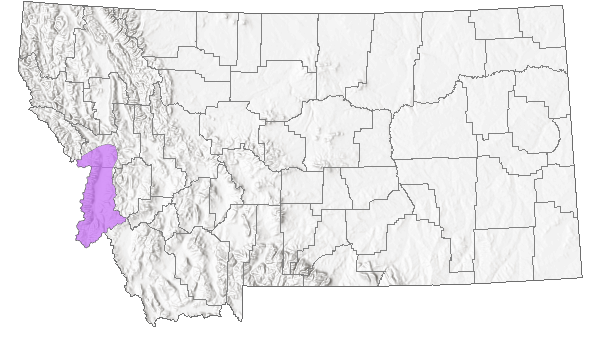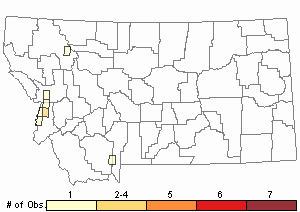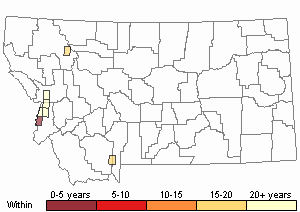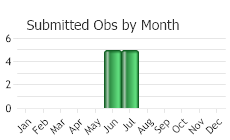View in other NatureServe Network Field Guides
NatureServe
Montana
Utah
Wyoming
Idaho
Wisconsin
British Columbia
South Carolina
Yukon
California
New York
Cup Clover - Trifolium cyathiferum
State Rank Reason (see State Rank above)
Trifolium cyathiferum occurs in two counties with limited information on population size. One occurrence was re-visited in 1998 and found to be absent due to habitat succession.
- Details on Status Ranking and Review
Range Extent
ScoreC - 250-1,000 sq km (~100-400 sq mi)
Area of Occupancy
ScoreD - 6-25 4-km2 grid cells
Number of Populations
ScoreB - 6 - 20
Number of Occurrences or Percent Area with Good Viability / Ecological Integrity
ScoreB - Very few (1-3) occurrences with excellent or good viability or ecological integrity
Environmental Specificity
ScoreD - Broad. Generalist or community with all key requirements common
Long-term Trend
ScoreU - Unknown
Trends
ScoreG - Relatively Stable (<=10% change)
Threats
ScoreD - Low
CommentThreat categories include: Climate change & severe weather, Habitat shifting & alteration, Other ecosystem modifications.
General Description
Plants: Cup Clover is a hairless annual herb with ascending or erect stems which stand 1-5 dm tall (Hitchcock 1961).
Leaves: Small "3-leaf clover" leaves are borne alternately on the stems, each leaf having 2 lanceolate stipules (appendages), 4-10 mm long (Lesica 2012), at the base of a long petiole (stalk) which bears 3 broadly oblanceolate leaflets; leaflets 5-25 mm long, with fine spiny-toothed margins much of their length (Hitchcock 1961).
Inflorescence: Clover heads are borne on leafless peduncles (stalks which support an inflorescence, in this case, racemose) from leaf axils. Each head consists of 5-30 flowers nestled within a spreading to somewhat deeply cupped, prominently veined saucer-like involucre (a whorl of bracts which subtend an inflorescence) with 6-15 shallow, finely bristled lobes that are fused together; the heads are 5-15 mm long and about the same width (Hitchcock 1961).
(Lesica’s contribution adapted from
Lesica et al. 2012. Manual of Montana Vascular Plants. BRIT Press. Fort Worth, TX)
Phenology
Flowers late May-August, subject to elevational differences (Barneby et al. 1989).
Diagnostic Characteristics
This species is distinguished from other Montana Trifolium species by the combination of its annual habit, flower heads subtended by a shallowly-lobed, glabrous involucre, and lower calyx teeth with 2-3 bristle-tips (
Lesica et al. 2012. Manual of Montana Vascular Plants. BRIT Press. Fort Worth, TX).
Species Range
Montana Range
Range Descriptions

 Native
Native
Range Comments
BC to CA, east to ID, NV and w MT. In Montana, Cup Clover is known from Missoula and Ravalli Counties (Lesica et al. 2012. Manual of Montana Vascular Plants. BRIT Press. Fort Worth, TX).
Observations in Montana Natural Heritage Program Database
Number of Observations: 10
(Click on the following maps and charts to see full sized version)
Map Help and Descriptions
Relative Density

Recency



 (Observations spanning multiple months or years are excluded from time charts)
(Observations spanning multiple months or years are excluded from time charts)
Habitat
Ecology
POLLINATORS The following animal species have been reported as pollinators of this plant species or its genus where their geographic ranges overlap:
Bombus vagans,
Bombus appositus,
Bombus auricomus,
Bombus bifarius,
Bombus borealis,
Bombus centralis,
Bombus fervidus,
Bombus flavifrons,
Bombus frigidus,
Bombus huntii,
Bombus melanopygus,
Bombus mixtus,
Bombus nevadensis,
Bombus rufocinctus,
Bombus sylvicola,
Bombus ternarius,
Bombus occidentalis,
Bombus pensylvanicus,
Bombus bimaculatus,
Bombus griseocollis,
Bombus impatiens,
Bombus insularis,
Bombus suckleyi,
Bombus bohemicus,
Bombus flavidus, and
Bombus kirbiellus (Plath 1934, Hobbs 1966, Macior 1974, Heinrich 1976, Bauer 1983, Thorp et al. 1983, Mayer et al. 2000, Rao and Stephen 2007, Wilson et al. 2010, Colla and Dumesh 2010, Colla et al. 2011, Koch and Strange 2012, Koch et al. 2012, Miller-Struttmann and Galen 2014, Williams et al. 2014).
Reproductive Characteristics
Flowers: The small flowers are about 2-5 mm long and have bilateral symmetry. The calyx has a 13- to 20-nerved tube and 5 teeth; the teeth are usually somewhat longer than the tube, the lower 3 each having 2 or 3 bristle-like tips. The white, cream, or pink corolla is about as long as the tips of the calyx teeth, and consists of a banner (the large, hooding, upper segment), the wings (the side segments) and a keel (the prow-shaped bottom segment) (Hitchcock 1961).
Fruit: The fruit is a pod, typically with 2 seeds (Hitchcock 1961).
Stewardship Responsibility
Threats or Limiting Factors
STATE THREAT SCORE REASON
Threat impact not assigned because threats are not known (MTNHP Threat Assessment 2021).
References
- Literature Cited AboveLegend:
 View Online Publication
View Online Publication Barneby, R.C., A. Cronquist, A.H. Holmgren, N.H. Holmgren, J.L. Reveal, P.K. Holmgren. 1989. Fabales. Intermountain Flora: Vascular Plants of the Intermountain West, U.S.A. Volume 3, Part B. Bronx, NY: New York Botanical Garden. 279 pp.
Barneby, R.C., A. Cronquist, A.H. Holmgren, N.H. Holmgren, J.L. Reveal, P.K. Holmgren. 1989. Fabales. Intermountain Flora: Vascular Plants of the Intermountain West, U.S.A. Volume 3, Part B. Bronx, NY: New York Botanical Garden. 279 pp. Bauer, P.J. 1983. Bumblebee pollination relationships on the Beartooth Plateau tundra of Southern Montana. American Journal of Botany. 70(1): 134-144.
Bauer, P.J. 1983. Bumblebee pollination relationships on the Beartooth Plateau tundra of Southern Montana. American Journal of Botany. 70(1): 134-144. Colla, S., L. Richardson, and P. Williams. 2011. Bumble bees of the eastern United States. Washington, DC: USDA Forest Service, Pollinator Partnership. 103 p.
Colla, S., L. Richardson, and P. Williams. 2011. Bumble bees of the eastern United States. Washington, DC: USDA Forest Service, Pollinator Partnership. 103 p. Colla, S.R. and S. Dumesh. 2010. The bumble bees of southern Ontario: notes on natural history and distribution. Journal of the Entomological Society of Ontario 141:39-68.
Colla, S.R. and S. Dumesh. 2010. The bumble bees of southern Ontario: notes on natural history and distribution. Journal of the Entomological Society of Ontario 141:39-68. Douglas, G.W., D. Meidinger, and J. Pojar, editors. 1999. Illustrated Flora of British Columbia. Volume 3. Dicotyledons (Diapensiaceae through Onagraceae). British Columbia Ministry of Environment, Lands and Parks, and British Columbia Ministry of Forests, Victoria.
Douglas, G.W., D. Meidinger, and J. Pojar, editors. 1999. Illustrated Flora of British Columbia. Volume 3. Dicotyledons (Diapensiaceae through Onagraceae). British Columbia Ministry of Environment, Lands and Parks, and British Columbia Ministry of Forests, Victoria. Hitchcock, C. L., A. Cronquist, M. Ownbey, and J. W. Thompson. 1961. Vascular Plants of the Pacific Northwest, Part 3. Saxifragaceae to Ericaceae. Seattle, WA and London, England: University of Washington. 614 pp.
Hitchcock, C. L., A. Cronquist, M. Ownbey, and J. W. Thompson. 1961. Vascular Plants of the Pacific Northwest, Part 3. Saxifragaceae to Ericaceae. Seattle, WA and London, England: University of Washington. 614 pp. Hobbs, G.A. 1966b. Ecology of species of Bombus Latr. (Hymenoptera: Apidae) in southern Alberta. V. Subgenus Subterraneobombus Vogt. Canadian Entomologist 98: 288-294.
Hobbs, G.A. 1966b. Ecology of species of Bombus Latr. (Hymenoptera: Apidae) in southern Alberta. V. Subgenus Subterraneobombus Vogt. Canadian Entomologist 98: 288-294. Koch, J., J. Strange, and P. Williams. 2012. Bumble bees of the western United States. Washington, DC: USDA Forest Service, Pollinator Partnership. 143 p.
Koch, J., J. Strange, and P. Williams. 2012. Bumble bees of the western United States. Washington, DC: USDA Forest Service, Pollinator Partnership. 143 p. Koch, J.B. and J.P. Strange. 2012. The status of Bombus occidentalis and B. moderatus in Alaska with special focus on Nosema bombi incidence. Northwest Science 86:212-220.
Koch, J.B. and J.P. Strange. 2012. The status of Bombus occidentalis and B. moderatus in Alaska with special focus on Nosema bombi incidence. Northwest Science 86:212-220. Lesica, P., M.T. Lavin, and P.F. Stickney. 2012. Manual of Montana Vascular Plants. Fort Worth, TX: BRIT Press. viii + 771 p.
Lesica, P., M.T. Lavin, and P.F. Stickney. 2012. Manual of Montana Vascular Plants. Fort Worth, TX: BRIT Press. viii + 771 p. Macior, L.M. 1974. Pollination ecology of the Front Range of the Colorado Rocky Mountains. Melanderia 15: 1-59.
Macior, L.M. 1974. Pollination ecology of the Front Range of the Colorado Rocky Mountains. Melanderia 15: 1-59. Mayer, D.F., E.R. Miliczky, B.F. Finnigan, and C.A. Johnson. 2000. The bee fauna (Hymenoptera: Apoidea) of southeastern Washington. Journal of the Entomological Society of British Columbia 97: 25-31.
Mayer, D.F., E.R. Miliczky, B.F. Finnigan, and C.A. Johnson. 2000. The bee fauna (Hymenoptera: Apoidea) of southeastern Washington. Journal of the Entomological Society of British Columbia 97: 25-31. Miller-Struttmann, N.E. and C. Galen. 2014. High-altitude multi-taskers: bumble bee food plant use broadens along an altitudinal productivity gradient. Oecologia 176:1033-1045.
Miller-Struttmann, N.E. and C. Galen. 2014. High-altitude multi-taskers: bumble bee food plant use broadens along an altitudinal productivity gradient. Oecologia 176:1033-1045. MTNHP Threat Assessment. 2021. State Threat Score Assignment and Assessment of Reported Threats from 2006 to 2021 for State-listed Vascular Plants. Botany Program, Montana Natural Heritage Program, Helena, Montana.
MTNHP Threat Assessment. 2021. State Threat Score Assignment and Assessment of Reported Threats from 2006 to 2021 for State-listed Vascular Plants. Botany Program, Montana Natural Heritage Program, Helena, Montana. Plath, O.E. 1934. Bumblebees and their ways. New York, NY: Macmillan Company. 201 p.
Plath, O.E. 1934. Bumblebees and their ways. New York, NY: Macmillan Company. 201 p. Rao, S. and W.P. Stephen. 2007. Bombus (Bombus) occidentalis (Hymenoptera: Apidae): In decline or recovery. Pan-Pacific Entomoligist 83(4): 360-362.
Rao, S. and W.P. Stephen. 2007. Bombus (Bombus) occidentalis (Hymenoptera: Apidae): In decline or recovery. Pan-Pacific Entomoligist 83(4): 360-362. Thorp, R.W., D.S. Horning, and L.L. Dunning. 1983. Bumble bees and cuckoo bumble bees of California (Hymenoptera: Apidae). Bulletin of the California Insect Survey 23:1-79.
Thorp, R.W., D.S. Horning, and L.L. Dunning. 1983. Bumble bees and cuckoo bumble bees of California (Hymenoptera: Apidae). Bulletin of the California Insect Survey 23:1-79. Williams, P., R. Thorp, L. Richardson, and S. Colla. 2014. Bumble Bees of North America. Princeton, NJ: Princeton University Press. 208 p.
Williams, P., R. Thorp, L. Richardson, and S. Colla. 2014. Bumble Bees of North America. Princeton, NJ: Princeton University Press. 208 p. Wilson, J.S., L.E. Wilson, L.D. Loftis, and T. Griswold. 2010. The montane bee fauna of north central Washington, USA, with floral associations. Western North American Naturalist 70(2): 198-207.
Wilson, J.S., L.E. Wilson, L.D. Loftis, and T. Griswold. 2010. The montane bee fauna of north central Washington, USA, with floral associations. Western North American Naturalist 70(2): 198-207.
- Additional ReferencesLegend:
 View Online Publication
View Online Publication
Do you know of a citation we're missing? Lesica, P., M.T. Lavin, and P.F. Stickney. 2022. Manual of Montana Vascular Plants, Second Edition. Fort Worth, TX: BRIT Press. viii + 779 p.
Lesica, P., M.T. Lavin, and P.F. Stickney. 2022. Manual of Montana Vascular Plants, Second Edition. Fort Worth, TX: BRIT Press. viii + 779 p.
- Web Search Engines for Articles on "Cup Clover"





